Driving 10X Growth With One Simple Model to Skyrocket Your App With Sean Casto From PreApps [AMP 189]
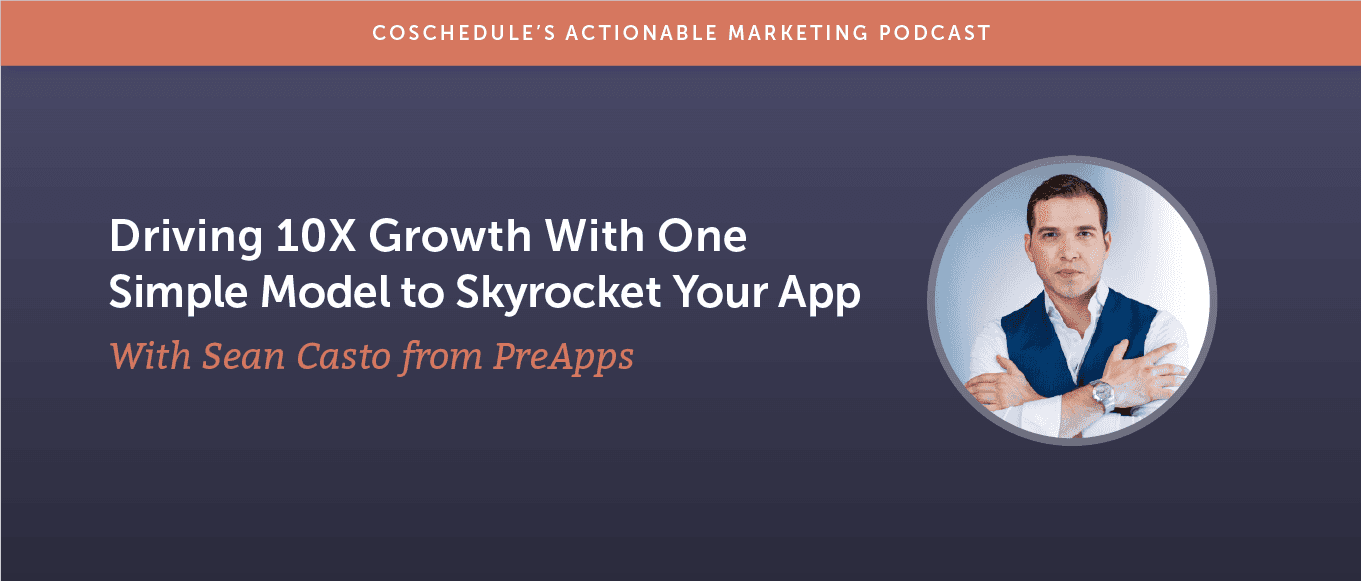 Some apps skyrocket, while others fly under the radar and fade away. Apps that succeed apply simple, yet effective tactics that drive rapid growth and sustain revenue.
Today’s guest is Sean Casto, founder and CEO of PreApps. Sean’s #1 app marketing agency in the United States offers proven strategies and techniques to achieve launch, download, and other goals for apps.
Some of the highlights of the show include:
Some apps skyrocket, while others fly under the radar and fade away. Apps that succeed apply simple, yet effective tactics that drive rapid growth and sustain revenue.
Today’s guest is Sean Casto, founder and CEO of PreApps. Sean’s #1 app marketing agency in the United States offers proven strategies and techniques to achieve launch, download, and other goals for apps.
Some of the highlights of the show include:
- 10X Revenue Model: Sean’s straightforward framework for building, scaling apps
- Step 1: Increase sales conversions
- Step 2: Increase prices and premium offers
- Step 3: Increase frequency of sales per user
- Step 4: Increase product offerings
- App Stats:
- 90% of marketplace apps make less than $500 per month
- 80% of app’s revenue comes from 20% of app’s customers
- Roadmap: Begin with end in mind without reinventing wheel, getting distracted
- “This model uses the same methods that billion-dollar apps, such as Tinder, Angry Birds, and Uber, have incorporated to be able to produce millions in additional revenue.”
- “Strategically guide your users to your offer. Don’t just make it easily available, but really make your offer truly irresistible.”
- “Boosting your prices and providing premium offers can easily incorporate and also drive extraordinary results.”
- “A million-dollar app starts with a million-dollar team. It’s understanding that you weren't meant to do this all on your own.”
Driving 10x growth with one simple model to skyrocket your app with Sean Casto from @PreApps.
Click To TweetTranscript:
Ben: Welcome to the show, Sean. Sean: Thank you so much for having me. Ben: Absolutely. Would you mind taking a moment to introduce yourself to our audience and explain what you do at PreApps? Sean: I'm the founder and CEO of PreApps. We're the number one app marketing agency here in the US, been around for well over eight years now, having worked with over 3000 apps reach over half a billion downloads. We work with startups to billion-dollar apps. I'm sure you're familiar with being able to reach their goals, whether that's launching successfully, or maybe they already have a million downloads, and I figure out how to go from a million downloads to 10 million downloads, or 10 million to 100 million downloads. We're able to assist with various different strategies and techniques to be able to accomplish that. Ben: Very cool. That's certainly an impressive resume, having worked with a high volume of apps and including a lot of apps that I and a lot of people in our audience have probably heard of and are familiar with. It sounds like you have a method or maybe it's a model, framework, whatever terms you'd like to use that you apply to help apps grow 10X. I believe you've pitched that as the 10X App Revenue Model. Would you mind explaining the basic principles behind how that works? Sean: Absolutely. Over the past eight years we've developed a number of different signature programs to be able to take apps from where you are now to where you aim to be, whether that's our Skyrocket Download Program or app [...] framework, but the one that you're referring to, is our 10X Revenue Model. Over the past, almost a decade now, after analyzing and working with some of the most successful highly profitable apps, my team and I at our agency PreApps have built a proven program that can exponentially increase sales and revenue to an app and we call it the 10X Revenue Model. Ben: You have a ton of experience in this space, and I imagine that model was built upon lessons you've learned from having years of experience and helping apps really accelerate their growth. Which specific experiences, lessons, thoughts, or philosophies that you've developed over the course of your career led most directly to the ideas behind this framework? Sean: This model uses the same methods that billion-dollar apps such as Tinder, Angry Birds, and Uber, have incorporated to be able to produce millions in additional revenue. What we've done is we've dissected and analyzed those types of established entities as well as the clients that we worked with to be able to figure out what works and how to be able to maximize those initiatives. Our 10X Revenue Model is just really four initiatives to be able to look at and examine to be able to maximize those returns.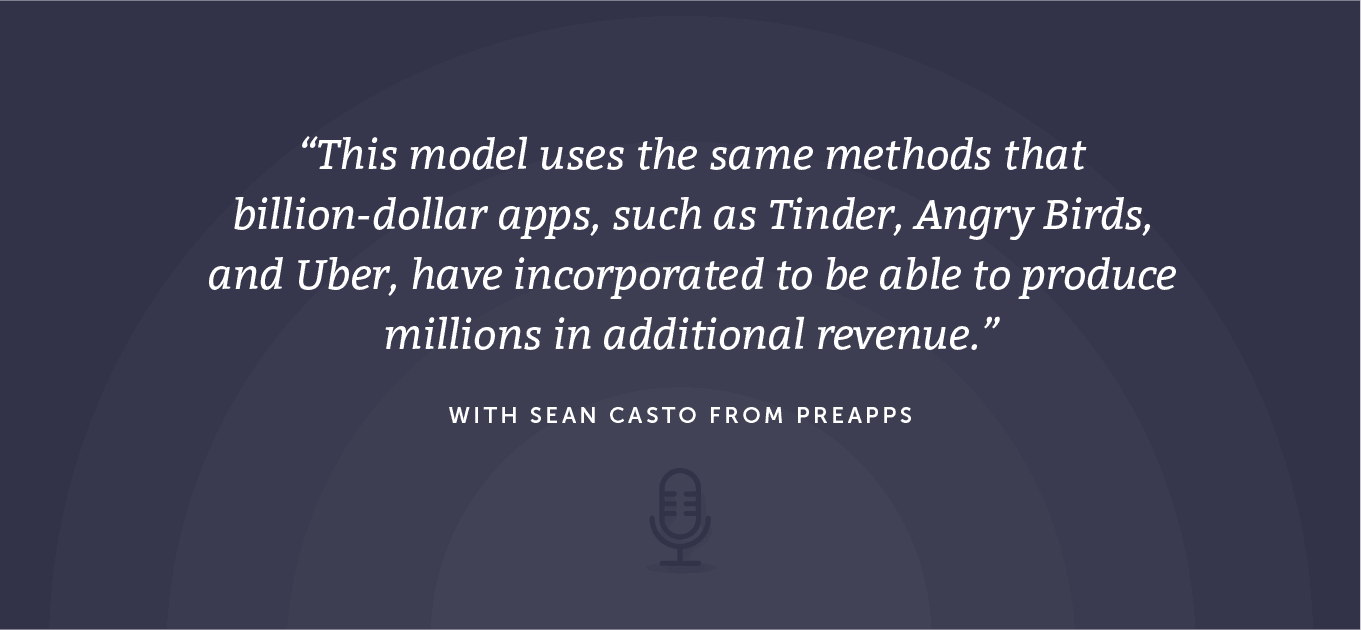 Ben: If I'm an app marketer or I'm an entrepreneur looking to launch an app, or (let's say) I am working with a company or an organization that has an app right now and we want to really just skyrocket the growth of that app, what's the very first thing that you would recommend I do to start applying your 10X Revenue Model?
Sean: I can break down those four steps. From a very high-level standpoint, obviously, there's a lot of detail that goes into each one of those, but the first step of our 10X Revenue Model is all about increasing your sales conversions. This process obviously requires tweaking how you market and present your offerings based on the category your app is in. It's about optimizing the sales copy of your in-app purchase offers.
Increasing your sales conversions really involves focusing on increasing those numbers of free users to the paid users. Really the key behind that is to strategically guide your users to your offer. Don't just make it easily available, but really make your offer truly irresistible. By making some tweaks and modifications to those initiatives can profoundly impact those conversion rates.
Ben: If I'm an app marketer or I'm an entrepreneur looking to launch an app, or (let's say) I am working with a company or an organization that has an app right now and we want to really just skyrocket the growth of that app, what's the very first thing that you would recommend I do to start applying your 10X Revenue Model?
Sean: I can break down those four steps. From a very high-level standpoint, obviously, there's a lot of detail that goes into each one of those, but the first step of our 10X Revenue Model is all about increasing your sales conversions. This process obviously requires tweaking how you market and present your offerings based on the category your app is in. It's about optimizing the sales copy of your in-app purchase offers.
Increasing your sales conversions really involves focusing on increasing those numbers of free users to the paid users. Really the key behind that is to strategically guide your users to your offer. Don't just make it easily available, but really make your offer truly irresistible. By making some tweaks and modifications to those initiatives can profoundly impact those conversion rates.
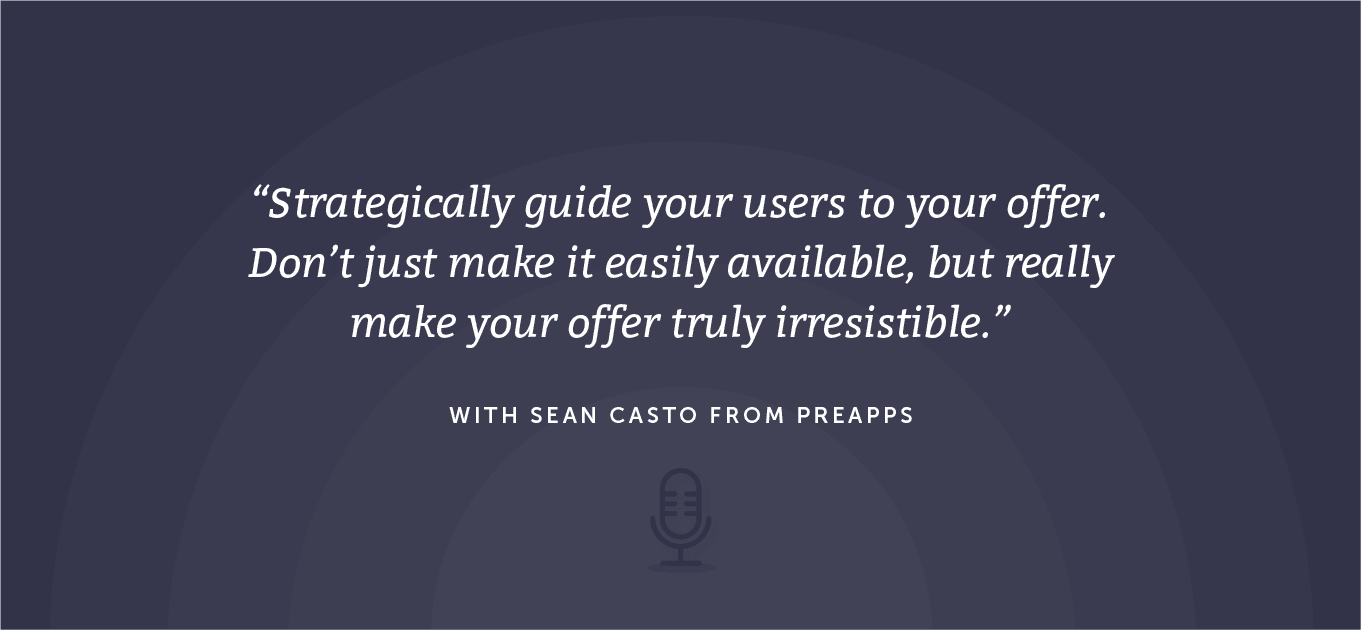 Step number two is really increasing your prices and premium offerings. That's going to be the next thing we really look at examining. Most apps undervalue by not having premium offers and therefore never really reach their full revenue potential. It really comes down to examining what's your perceived value you're offering, how do you maximize that value to your users.
Boosting your prices and providing that premium offer can easily incorporate and also drive extraordinary results from that. Every app you can think of. Every billion-dollar app has been offered premium services. Angry Birds, for example, has an in-app purchase available for $100. Candy Crush, Tinder has a monthly subscription up to $100 a month. It's really understanding what these billion dollar apps pricing themselves at.
Step number two is really increasing your prices and premium offerings. That's going to be the next thing we really look at examining. Most apps undervalue by not having premium offers and therefore never really reach their full revenue potential. It really comes down to examining what's your perceived value you're offering, how do you maximize that value to your users.
Boosting your prices and providing that premium offer can easily incorporate and also drive extraordinary results from that. Every app you can think of. Every billion-dollar app has been offered premium services. Angry Birds, for example, has an in-app purchase available for $100. Candy Crush, Tinder has a monthly subscription up to $100 a month. It's really understanding what these billion dollar apps pricing themselves at.
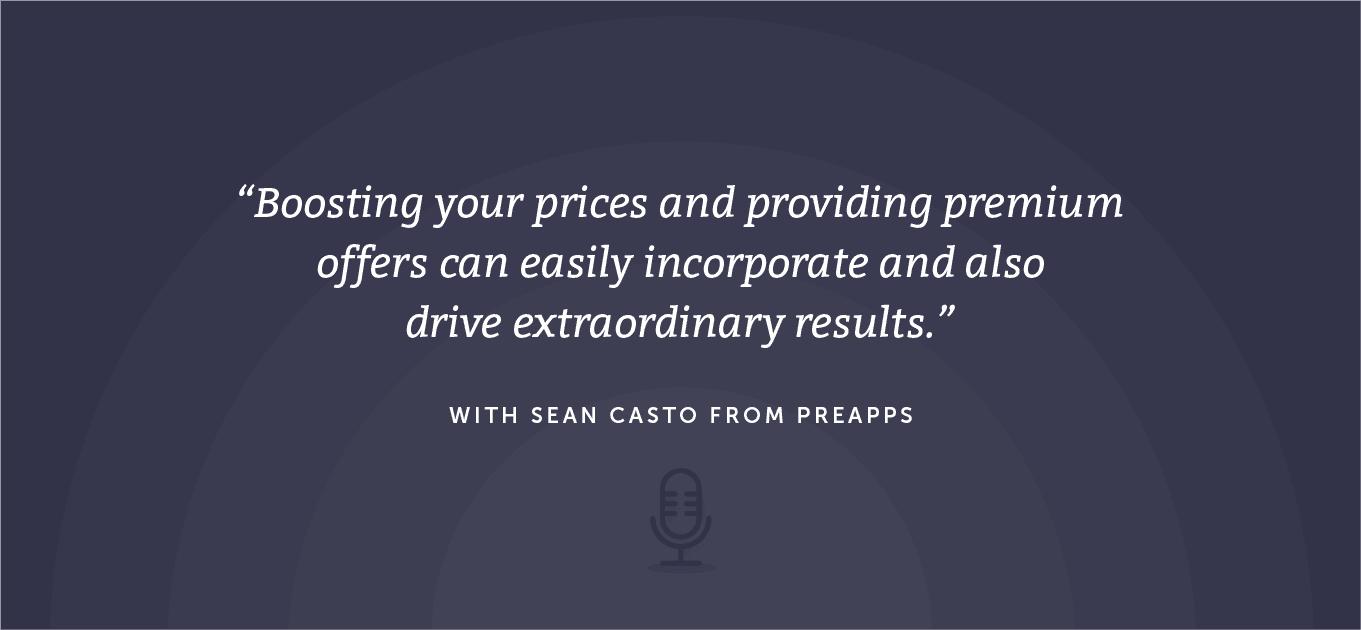 There's a reason why they offer these very high-end initiatives, and a lot of apps out there statistically, 90% of apps out there in the marketplace, make less than $500 per month. That's due to the fact of not just obviously pricing issues, but more marketing issues of getting users. The problem is a lot of them just also undervalue themselves in that capacity. That's what we look at is really understanding how we can maximize those pricing models.
Step number three of our 10X Revenue Model is all about increasing the frequency of sales per user. According to the Gartner Group, 80% of future profits come from just 20% of existing customers. If you're able to really maximize your existing users so that they don't only purchase you from once in a year, but actually maybe 5, 10, 100 times over the year, that obviously will have a profound impact on the bottom line. So, that's where we look at.
Incorporating things like a ‘buy all’ option, or discounted options for unlocking all benefits, and upselling other initiatives within your app. By being able to change the copy and marketing of how you're offering your products and services, you're able to continually maximize the sales per user so that they are able to come back to the app multiple times and on a regular basis.
Step number four, the last one of our 10X Revenue Model, is all about increasing your product offerings. One thing that most don't know is not only do you need to increase pricing but increasing your business model so that you're not just making revenue from one channel but an omnipresence of various different channels.
Tinder is a good example. Not only do they have in-app purchases, but they also offer advertising. They make money through advertising. They also have a subscription model. They're able to pool all these various different business models and to be able to maximize on each. The average app 95% of apps only have one business model, whether that's just making money from advertising or just making any money from one-time in-app purchases.
Whereas the successful apps out there who are making tens of millions of dollars a month, they're able to leverage a number of different business models, whether it's through merchandising or subscription model, plus advertising, plus in-app purchases to be able to really maximize their returns. That’s what we look at and be able to incorporate.
Ben: I think it's particularly interesting what you're just talking about with diversifying revenue streams and expanding your product offerings beyond just what your initial app or your core service might be. I could really see that same mentality applying beyond apps to Software as a Service-type companies like ourselves at CoSchedule and other companies of that nature as well.
Sean: Exactly. You got to start off with obviously having a foundation like what's the major revenue driver, and then you're able to expand off that. For example, it's reported that 50% of Angry Birds revenue is now outside of their app, through licensing deals and merchandising. It's pretty incredible given the fact that Angry Birds was originally a game that made all its money from in-app purchases, but now they're making hundreds of millions of dollars outside of having an app. The same ideas can be applied to other businesses, whether it's software or retail, and a lot of it comes down to, once you have that established brand and you're able to leverage that to do various different models.
Ben: 80% of app revenues come from 20% of an app's customers. That is an extremely interesting statistic because it tells us that the fastest path to growing an app might not only be getting more users but by better serving the best customers you already have. It's such a simple thought, it's a seemingly simple statistic, but it's one that I think is really worth thinking about because what that means for your strategy and for your tactics is really big.
If you're throwing all of your efforts into just getting more and more and more, whether it's more traffic, more customers but you're just churning and burning through them, it might really be worth it to just take a step back and just think, instead of trying to grow 80% of our audience, how can we just build better relationships with the 20% that really care about us? Now back to Sean.
Let's go back to our example of the app marketer or the entrepreneur out there who's looking to really apply this framework, so their own app or their own company. Once you have a successful core offering that you have an app or a service that you've got it really dialed in, it's doing well, it's making money, it's growing but you don't want to put all your eggs in one basket, you want to start doing what you're saying and start diversifying your products and your offerings, how would you recommend that person start exploring what other opportunities they might have available to them?
Let's say they're really good at selling this one thing. How do they identify the next one, two, three other things, and prioritize those things that they should go after without distracting themselves too much from what they're good at?
Sean: A lot of it will come down to having that roadmap of what you're looking to achieve. Understanding what that end goal is and what time frame you're looking to achieve that, one thing that we always consult with our clients. You want to begin with the end in mind. If you have a specific objective, you just work backward to be able to make that happen in terms of pricing and strategy.
The other big component is you don't need to reinvent the wheel. Success leaves clues so that you're able to understand and analyze what are the biggest players doing the billion-dollar apps. You can actually save yourself millions of dollars in testing by just incorporating the strategies and models that have already proven to work. That's the first step is to understand is, okay, well, if it works for this type of company, software, product, or app then switch hands, it'll work for you if it's a similar business.
That's where the focus point should be on. After that is really just working with the experts to be able to incorporate that. A million-dollar app starts with a million dollar team, and it's understanding that you weren't meant to do this on your own. You don't have to figure it out on your own.
There's a reason why they offer these very high-end initiatives, and a lot of apps out there statistically, 90% of apps out there in the marketplace, make less than $500 per month. That's due to the fact of not just obviously pricing issues, but more marketing issues of getting users. The problem is a lot of them just also undervalue themselves in that capacity. That's what we look at is really understanding how we can maximize those pricing models.
Step number three of our 10X Revenue Model is all about increasing the frequency of sales per user. According to the Gartner Group, 80% of future profits come from just 20% of existing customers. If you're able to really maximize your existing users so that they don't only purchase you from once in a year, but actually maybe 5, 10, 100 times over the year, that obviously will have a profound impact on the bottom line. So, that's where we look at.
Incorporating things like a ‘buy all’ option, or discounted options for unlocking all benefits, and upselling other initiatives within your app. By being able to change the copy and marketing of how you're offering your products and services, you're able to continually maximize the sales per user so that they are able to come back to the app multiple times and on a regular basis.
Step number four, the last one of our 10X Revenue Model, is all about increasing your product offerings. One thing that most don't know is not only do you need to increase pricing but increasing your business model so that you're not just making revenue from one channel but an omnipresence of various different channels.
Tinder is a good example. Not only do they have in-app purchases, but they also offer advertising. They make money through advertising. They also have a subscription model. They're able to pool all these various different business models and to be able to maximize on each. The average app 95% of apps only have one business model, whether that's just making money from advertising or just making any money from one-time in-app purchases.
Whereas the successful apps out there who are making tens of millions of dollars a month, they're able to leverage a number of different business models, whether it's through merchandising or subscription model, plus advertising, plus in-app purchases to be able to really maximize their returns. That’s what we look at and be able to incorporate.
Ben: I think it's particularly interesting what you're just talking about with diversifying revenue streams and expanding your product offerings beyond just what your initial app or your core service might be. I could really see that same mentality applying beyond apps to Software as a Service-type companies like ourselves at CoSchedule and other companies of that nature as well.
Sean: Exactly. You got to start off with obviously having a foundation like what's the major revenue driver, and then you're able to expand off that. For example, it's reported that 50% of Angry Birds revenue is now outside of their app, through licensing deals and merchandising. It's pretty incredible given the fact that Angry Birds was originally a game that made all its money from in-app purchases, but now they're making hundreds of millions of dollars outside of having an app. The same ideas can be applied to other businesses, whether it's software or retail, and a lot of it comes down to, once you have that established brand and you're able to leverage that to do various different models.
Ben: 80% of app revenues come from 20% of an app's customers. That is an extremely interesting statistic because it tells us that the fastest path to growing an app might not only be getting more users but by better serving the best customers you already have. It's such a simple thought, it's a seemingly simple statistic, but it's one that I think is really worth thinking about because what that means for your strategy and for your tactics is really big.
If you're throwing all of your efforts into just getting more and more and more, whether it's more traffic, more customers but you're just churning and burning through them, it might really be worth it to just take a step back and just think, instead of trying to grow 80% of our audience, how can we just build better relationships with the 20% that really care about us? Now back to Sean.
Let's go back to our example of the app marketer or the entrepreneur out there who's looking to really apply this framework, so their own app or their own company. Once you have a successful core offering that you have an app or a service that you've got it really dialed in, it's doing well, it's making money, it's growing but you don't want to put all your eggs in one basket, you want to start doing what you're saying and start diversifying your products and your offerings, how would you recommend that person start exploring what other opportunities they might have available to them?
Let's say they're really good at selling this one thing. How do they identify the next one, two, three other things, and prioritize those things that they should go after without distracting themselves too much from what they're good at?
Sean: A lot of it will come down to having that roadmap of what you're looking to achieve. Understanding what that end goal is and what time frame you're looking to achieve that, one thing that we always consult with our clients. You want to begin with the end in mind. If you have a specific objective, you just work backward to be able to make that happen in terms of pricing and strategy.
The other big component is you don't need to reinvent the wheel. Success leaves clues so that you're able to understand and analyze what are the biggest players doing the billion-dollar apps. You can actually save yourself millions of dollars in testing by just incorporating the strategies and models that have already proven to work. That's the first step is to understand is, okay, well, if it works for this type of company, software, product, or app then switch hands, it'll work for you if it's a similar business.
That's where the focus point should be on. After that is really just working with the experts to be able to incorporate that. A million-dollar app starts with a million dollar team, and it's understanding that you weren't meant to do this on your own. You don't have to figure it out on your own.
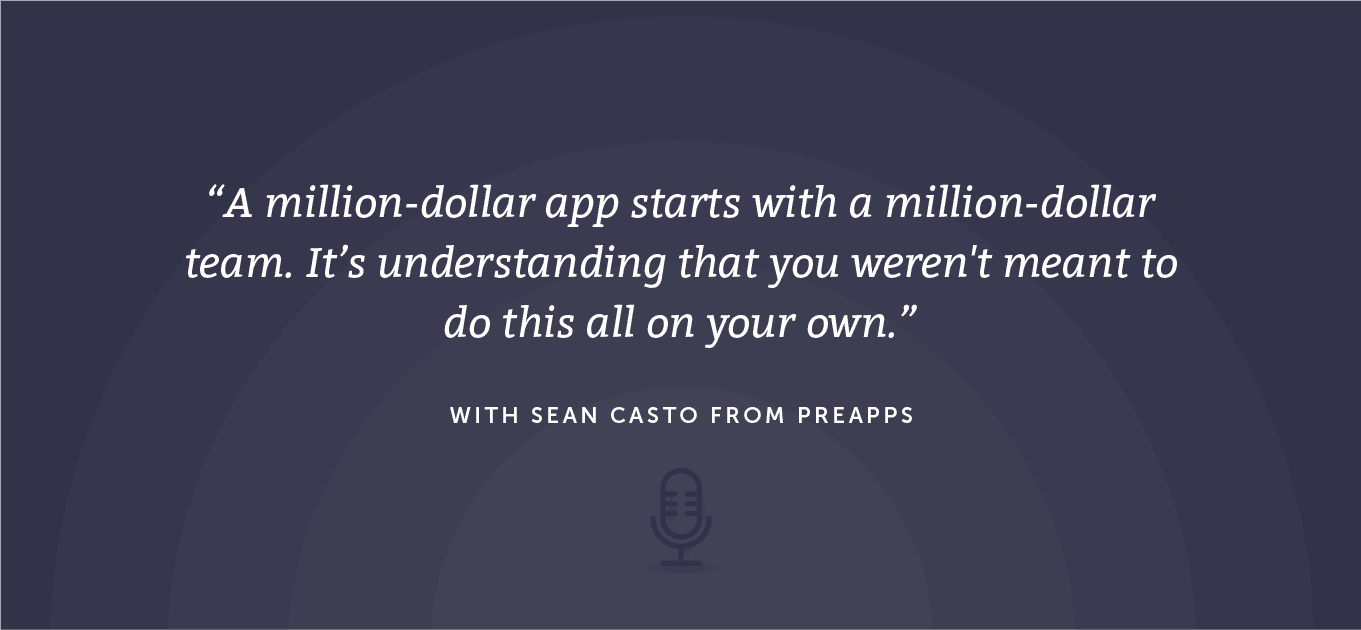 If you're the CEO or business owner listening right now, it's not your job to figure out the strategy or the how. It's really more of the who. Who can actually incorporate this technique or reach those goals for you? That's where incorporating a team or working with an agency like ours to be able to assist and execute.
Ben: That's all great advice. I think it sounds like a very practical, very actionable model for app companies, and maybe software service providers to follow, but let's say I'm a marketer or I'm an entrepreneur. I've made it this far into this conversation, but I don't have an app and I'm not a software company. I would say I'm in some other completely different space, industry, or vertical. Are there any basic underlying principles, though, that underpin this model that could also apply for them. Are there things that would be transferable maybe to other industries or to other verticals?
Sean: Of course. These are foundational principles that can be really applied to any business that obviously is generating revenue or plans of generating this won't necessarily work for nonprofits, but it really comes down to the core principles of, okay, the first step is getting more people in the door, getting more users. The second step is how do you maximize the revenue of that user in terms of either increasing pricing or having that user purchase multiple times, increasing that lifetime value. The third piece is there is understanding how you can incorporate other revenue models to be able to maximize those sales.
The biggest thing that a lot of people fail in is basically, marketers are always focusing on getting new users or new customers, as opposed to maximizing the existing ones that have already come through the door and previously purchased. Someone who has made a purchase is 70% more inclined to purchase again.
That's where that 80/20 comes back into play where 80% of your future profits will come from just 20% of your existing users. It's all about really understanding your retention and getting those people coming back because retention equals growth.
Ben: This is great stuff, Sean. Before I let you go, is there anything else you'd like to mention? Is there anything else about this revenue model that you've put together, that you think is really important for our audience to understand that you maybe haven't had a chance to mention?
Sean: No, I think we've covered the fundamentals of those initiatives. If you want to learn more about that, we have a few different resources. You can go to the App Secrets Podcast or App Marketing Secrets Podcast. We have a few episodes that go into detail about the 10X Revenue Model as well. A lot of our other blueprints, and then on our website, we also have a lot of free resources there at preapps.com.
If you're the CEO or business owner listening right now, it's not your job to figure out the strategy or the how. It's really more of the who. Who can actually incorporate this technique or reach those goals for you? That's where incorporating a team or working with an agency like ours to be able to assist and execute.
Ben: That's all great advice. I think it sounds like a very practical, very actionable model for app companies, and maybe software service providers to follow, but let's say I'm a marketer or I'm an entrepreneur. I've made it this far into this conversation, but I don't have an app and I'm not a software company. I would say I'm in some other completely different space, industry, or vertical. Are there any basic underlying principles, though, that underpin this model that could also apply for them. Are there things that would be transferable maybe to other industries or to other verticals?
Sean: Of course. These are foundational principles that can be really applied to any business that obviously is generating revenue or plans of generating this won't necessarily work for nonprofits, but it really comes down to the core principles of, okay, the first step is getting more people in the door, getting more users. The second step is how do you maximize the revenue of that user in terms of either increasing pricing or having that user purchase multiple times, increasing that lifetime value. The third piece is there is understanding how you can incorporate other revenue models to be able to maximize those sales.
The biggest thing that a lot of people fail in is basically, marketers are always focusing on getting new users or new customers, as opposed to maximizing the existing ones that have already come through the door and previously purchased. Someone who has made a purchase is 70% more inclined to purchase again.
That's where that 80/20 comes back into play where 80% of your future profits will come from just 20% of your existing users. It's all about really understanding your retention and getting those people coming back because retention equals growth.
Ben: This is great stuff, Sean. Before I let you go, is there anything else you'd like to mention? Is there anything else about this revenue model that you've put together, that you think is really important for our audience to understand that you maybe haven't had a chance to mention?
Sean: No, I think we've covered the fundamentals of those initiatives. If you want to learn more about that, we have a few different resources. You can go to the App Secrets Podcast or App Marketing Secrets Podcast. We have a few episodes that go into detail about the 10X Revenue Model as well. A lot of our other blueprints, and then on our website, we also have a lot of free resources there at preapps.com.




